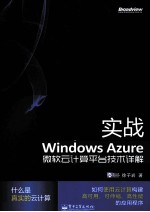

实战Windows Azure 微软云计算平台技术详解PDF电子书下载
- 电子书积分:14 积分如何计算积分?
- 作 者:徐子岩著
- 出 版 社:北京:电子工业出版社
- 出版年份:2011
- ISBN:7121145476
- 页数:423 页
第1章 云计算技术简介 1
1.1云计算所要解决的问题 1
1.2云计算平台的分类 3
1.3微软云计算平台Windows Azure 5
1.3.1高可用性 5
1.3.2易于部署和伸缩 5
1.3.3全球化 6
1.3.4开发语言和开发模型 7
第2章Windows Azure云计算平台 9
2.1 Windows Azure平台的组成部分和主要功能 9
2.1.1 Windows Azure 9
2.1.2 Windows Azure相关名词 11
2.1.3 SQL Azure 15
2.1.4 Windows Azure AppFabric 16
2.1.5 Windows Azure Connect 17
2.2 Windows Azure收费模式 18
2.2.1 Windows Azure账户 18
2.2.2 Windows Azure的计费模式 18
2.3 Windows Azure平台成本及性能案例分析 21
2.3.1北欧某健康资讯网站 21
2.3.2挪威某零售业管理系统 23
2.3.3某企业应用平台 23
第3章Windows Azure计算服务 25
3.1准备Windows Azure开发环境 25
3.2第一个Windows Azure应用程序 28
3.2.1创建Cloud Project和Web Role 28
3.2.2使用本地模拟器运行和调试Azure应用程序 30
3.2.3购买Windows Azure 32
3.2.4通过Developer Portal创建Hosted Service 34
3.2.5向Staging环境部署Windows Azure应用 39
3.2.6向Production环境切换 43
3.3 Windows Azure项目组成 44
3.3.1 Windows Azure Project介绍 45
3.3.2 Role及其生命周期模型 55
3.3.3 Confiiguration的变更和通知机制 58
3.3.4 Windows Azure本地模拟器 63
第4章Windows Azure存储服务 665
4.1创建新的Storage Service 66
4.2使用Table Service 69
4.2.1 Table Service的特点 70
4.2.2使用Table Storage保存相册信息 74
4.2.3基于Repository模式的Table Service数据访问层 90
4.2.4使用Table Service的事务操作 98
4.3使用BLOB Service 103
4.3.1 BLOB Service的特点 104
4.3.2使用BLOB Service保存照片 109
4.3.3使用Shared Access Signatures 121
4.3.4使用Cloud Drive 125
4.4使用Queue Service 133
4.4.1 Queue Service的组成及特点 133
4.4.2在创建照片部分加入生成缩略图的Queue Message 135
4.4.3创建生成缩略图的Worker Role 137
4.4.4实现生成缩略图操作 139
第5章Windows Azure部署与管理 148
5.1使用Visual Studio部署Azure应用 148
5.1.1 Windows Azure Management API介绍 148
5.1.2配置Management API证书 151
5.1.3通过Visual Studio部署 155
5.2管理Windows Azure 158
5.2.1 Windows Azure平台高可用性的实现 159
5.2.2部署与就地升级 160
5.2.3 VIP转换 160
5.2.4 Windows Azure平台的管理工具 162
5.3使用Windows Azure诊断服务 173
5.3.1 Diagnostics Monitor介绍 174
5.3.2通过代码启动Diagnostics Monitor 176
5.3.3通过代码配置Diagnostics Monitor 180
5.3.4通过远程API配置Diagnostics Monitor 184
5.3.5使用NLog扩展在Windows Azure平台输出日志 188
5.3.6使用IntelliTrace获取异常信息 193
5.4回顾与总结 198
第6章SQL Azure 200
6.1 SQL Azure特点 200
6.1.1易于维护和高可用性 201
6.1.2弹性和伸缩性 201
6.1.3开发方式的一贯性 202
6.2 SQL Azure的订阅模式 202
6.3 SQL Azure服务器端架构 203
6.4 SQL Azure与SQL Server的差异 205
6.5创建SQL Azure服务 206
6.5.1创建SQL Azure Server 206
6.5.2通过Developer Portal创建数据库 209
6.6使用工具管理SQL Azure 211
6.6.1使用SQL Server Management Studio管理SQL Azure 211
6.6.2使用Project Houston管理SQL Azure 214
6.7使用SQL Azure 217
6.7.1创建Aurora的SQL Azure数据库 218
6.7.2向SQL Azure导入数据 222
6.7.3在应用程序中使用SQL Azure 224
6.7.4基于Windows Azure和SQL Azure的开发部署流程 229
6.8回顾与总结 231
第7章Windows Azure AppFabric 232
7.1服务总线(Service Bus) 233
7.1.1 Service Bus的工作方式 234
7.1.2使用Service Remoting开放本地的地理位置服务 237
7.1.3使用Eventing模式 246
7.1.4配置Service Bus运行环境 251
7.2访问控制服务(Access Control Service) 253
7.2.1访问控制服务的原理 253
7.2.2为地理位置服务加入访问控制 255
7.3回顾与总结 266
第8章Windows Azure平台高级应用 267
8.1 Role Endpoint和内部通信 267
8.1.1 Role Endpoint介绍 267
8.1.2基于Input Endpoint通过Worker Role发布WCF服务 269
8.1.3动态指定WCF的发布地址 273
8.1.4使用Internal Endpoint实现Role的内部通信 275
8.1.5总结 279
8.2通过远程桌面功能访问Windows Azure的虚拟机 279
8.2.1通过Visual Studio配置远程桌面功能 279
8.2.2总结 285
8.3通过Windows Azure Connect实现本地计算机和云端虚拟机的互连 285
8.3.1什么是Windows Azure Connect 286
8.3.2申请Windows Azure Beta Program 287
8.3.3将本地计算机和Azure VM加入Connect 288
8.3.4 Windows Azure Connect的功能 294
8.4 Web Role的Full IIS特性 296
8.4.1基于Hosted Web Core方式部署Web Role 296
8.4.2基于Full IIS部署Web Role 298
8.4.3使用Full IIS时的注意事项 300
8.4.4使用Full IIS模式部署多站点和虚拟目录 301
8.4.5总结 305
8.5通过Startup功能实现COM组件调用 305
8.5.1使用Startup功能执行简单的命令 305
8.5.2 Startup配置项介绍 307
8.5.3使用Startup功能注册COM组件 307
8.6使用Windows Azure CDN 309
8.6.1 Windows Azure CDN的原理 309
8.6.2使用Blob Service CDN 313
8.6.3使用Hosted Service CDN 316
8.6.4总结 319
8.7云端的分布式缓存服务AppFabric Cache 319
8.7.1缓存与分布式缓存 319
8.7.2创建Windows Azure AppFabric Cache 322
8.7.3使用Windows Azure AppFabric Cache 324
8.7.4总结 331
8.8 Access Control Service 2.0 332
8.8.1 ACS v2和统一认证 332
8.8.2 ACS v2的认证流程 334
8.8.3基于Live ID和Google ID的ASP.NET MVC网站 336
8.8.4控制ACS的验证逻辑 344
8.9云端的报表:SQL Azure Reporting CTP 352
8.10为SQL Azure实现备份和恢复功能 361
8.10.1使用Database Copy 361
8.10.2使用Data-tier Application Framework 2.0 363
8.10.3使用SQL Azure Data Sync CTP 371
8.10.4三种SQL Azure备份恢复实现的对比 378
8.11基于SQL Azure数据库的OData服务 379
8.12 Windows Azure与扩展性 382
8.12.1横向扩展和纵向扩展 382
8.12.2应用程序层的横向扩展 385
8.12.3数据层的横向扩展 389
8.12.4 SQL Azure Federation预览 395
8.12.5总结 399
8.13异步工作模型 400
8.13.1什么是异步工作模型 400
8.13.2 Windows Azure中的异步工作模型 402
8.13.3在Aurora项目中实现异步工作模型 410
8.13.4总结 421
本书参考资料 422
- 《钒产业技术及应用》高峰,彭清静,华骏主编 2019
- 《计算机网络与通信基础》谢雨飞,田启川编著 2019
- 《大学计算机实验指导及习题解答》曹成志,宋长龙 2019
- 《现代水泥技术发展与应用论文集》天津水泥工业设计研究院有限公司编 2019
- 《异质性条件下技术创新最优市场结构研究 以中国高技术产业为例》千慧雄 2019
- 《Prometheus技术秘笈》百里燊 2019
- 《中央财政支持提升专业服务产业发展能力项目水利工程专业课程建设成果 设施农业工程技术》赵英编 2018
- 《药剂学实验操作技术》刘芳,高森主编 2019
- 《林下养蜂技术》罗文华,黄勇,刘佳霖主编 2017
- 《脱硝运行技术1000问》朱国宇编 2019
- 《中国古典舞扇舞研究》胡岩著 2019
- 《新时代马克思主义新闻观七讲》董岩著 2019
- 《零基础学拔罐》杨秀岩著 2018
- 《新零基础学刮痧》杨秀岩著 2018
- 《数据分析与云计算技术研究》闫岩著 2019
- 《西游记那些事》自在岩著 2018
- 《赤子之殇》周徐子著 2014
- 《历史在这里沉思1966-1976年记实 第3卷》周明主编;刘茵,徐子芳编选 1987
- 《飞跃星河的爱恋》徐子均 2018
- 《幼儿园教学与管理》郑素岩著 2016
- 《电子测量与仪器》人力资源和社会保障部教材办公室组织编写 2009
- 《少儿电子琴入门教程 双色图解版》灌木文化 2019
- 《指向核心素养 北京十一学校名师教学设计 英语 七年级 上 配人教版》周志英总主编 2019
- 《北京生态环境保护》《北京环境保护丛书》编委会编著 2018
- 《指向核心素养 北京十一学校名师教学设计 英语 九年级 上 配人教版》周志英总主编 2019
- 《通信电子电路原理及仿真设计》叶建芳 2019
- 《高等院校旅游专业系列教材 旅游企业岗位培训系列教材 新编北京导游英语》杨昆,鄢莉,谭明华 2019
- 《电子应用技术项目教程 第3版》王彰云 2019
- 《中国十大出版家》王震,贺越明著 1991
- 《近代民营出版机构的英语函授教育 以“商务、中华、开明”函授学校为个案 1915年-1946年版》丁伟 2017
